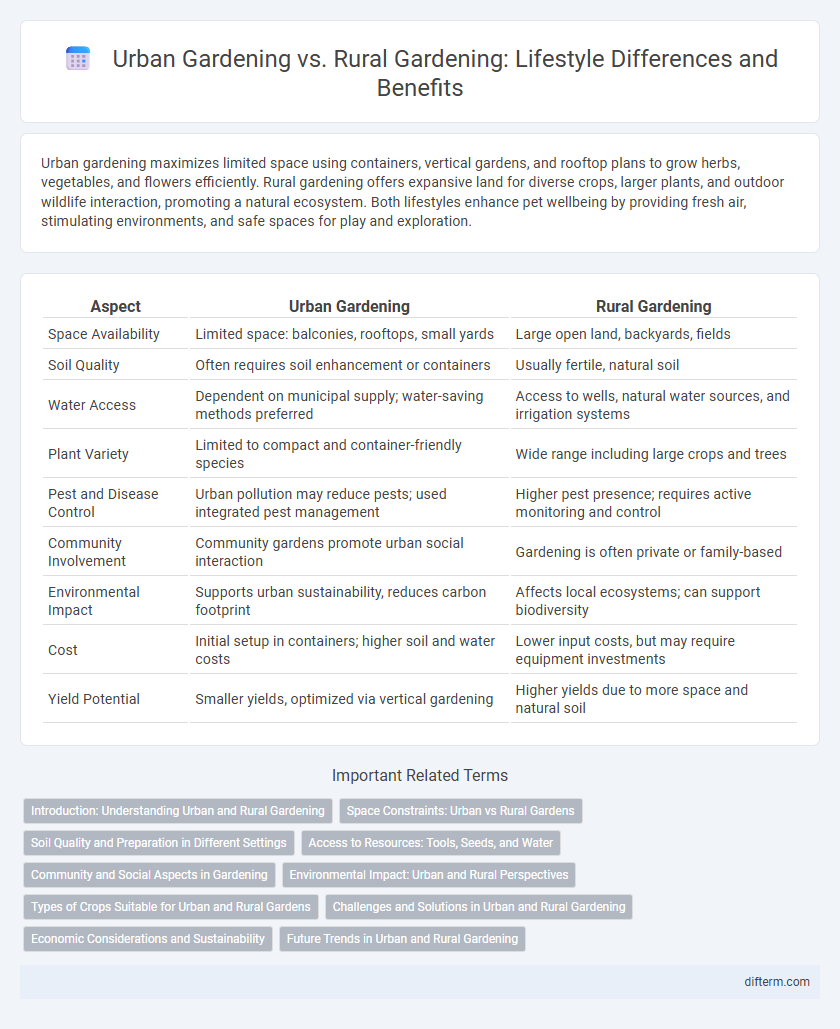Urban gardening maximizes limited space using containers, vertical gardens, and rooftop plans to grow herbs, vegetables, and flowers efficiently. Rural gardening offers expansive land for diverse crops, larger plants, and outdoor wildlife interaction, promoting a natural ecosystem. Both lifestyles enhance pet wellbeing by providing fresh air, stimulating environments, and safe spaces for play and exploration.
Table of Comparison
| Aspect | Urban Gardening | Rural Gardening |
|---|---|---|
| Space Availability | Limited space: balconies, rooftops, small yards | Large open land, backyards, fields |
| Soil Quality | Often requires soil enhancement or containers | Usually fertile, natural soil |
| Water Access | Dependent on municipal supply; water-saving methods preferred | Access to wells, natural water sources, and irrigation systems |
| Plant Variety | Limited to compact and container-friendly species | Wide range including large crops and trees |
| Pest and Disease Control | Urban pollution may reduce pests; used integrated pest management | Higher pest presence; requires active monitoring and control |
| Community Involvement | Community gardens promote urban social interaction | Gardening is often private or family-based |
| Environmental Impact | Supports urban sustainability, reduces carbon footprint | Affects local ecosystems; can support biodiversity |
| Cost | Initial setup in containers; higher soil and water costs | Lower input costs, but may require equipment investments |
| Yield Potential | Smaller yields, optimized via vertical gardening | Higher yields due to more space and natural soil |
Introduction: Understanding Urban and Rural Gardening
Urban gardening maximizes limited space by using containers, rooftop gardens, and vertical planting to grow vegetables, herbs, and flowers in city environments. Rural gardening benefits from expansive land, richer soil, and natural ecosystems, allowing for larger-scale cultivation and diverse crop production. Both practices contribute to sustainable living by enhancing food security, promoting biodiversity, and reducing environmental impact through localized food sources.
Space Constraints: Urban vs Rural Gardens
Urban gardening maximizes limited space using vertical planters, container gardens, and rooftop plots, often adapted for small balconies and patios. Rural gardening benefits from expansive land, allowing for larger plots, diverse crop rotations, and traditional row planting without spatial restrictions. Space constraints in urban environments drive innovative growing techniques, while rural gardens leverage natural space for scalability and biodiversity.
Soil Quality and Preparation in Different Settings
Urban gardening often faces challenges with soil contamination and limited space, requiring raised beds and imported soil to ensure proper nutrient balance and drainage. In contrast, rural gardening benefits from naturally richer soil that typically requires less intervention but may need specific amendments to correct pH or replenish nutrients after crop rotation. Both settings demand tailored preparation techniques to optimize soil quality for plant health and productivity.
Access to Resources: Tools, Seeds, and Water
Urban gardening offers convenient access to diverse seeds and specialized tools from nearby stores, while water availability often depends on municipal supply and rainwater harvesting systems. Rural gardening benefits from natural water sources like rivers and wells, with easy access to bulk seeds and traditional farming tools due to larger spaces and less commercial reliance. Access to resources shapes the scale and techniques of gardening, with urban areas favoring container and vertical gardening and rural areas supporting expansive cultivation.
Community and Social Aspects in Gardening
Urban gardening fosters tight-knit communities by transforming shared spaces into collective gardens, encouraging collaboration and social interaction among diverse city residents. Rural gardening often revolves around family traditions and local networks, strengthening bonds through generations and regional practices. Both settings enhance social well-being but differ in scale and the nature of community engagement.
Environmental Impact: Urban and Rural Perspectives
Urban gardening reduces carbon footprints by minimizing transportation emissions and repurposes limited city spaces to enhance biodiversity. Rural gardening often involves larger plots that support diverse ecosystems but may rely on fossil fuel-powered machinery, increasing environmental impact. Sustainable practices in both settings, such as composting and organic cultivation, significantly mitigate negative effects on the environment.
Types of Crops Suitable for Urban and Rural Gardens
Urban gardening typically favors compact, high-yield crops such as herbs, leafy greens, and cherry tomatoes that thrive in container or raised bed setups with limited space. Rural gardening allows for a broader range of crops including root vegetables, large fruit-bearing plants like pumpkins, and staple grains due to ample land and richer soil conditions. Crop selection in both environments hinges on available space, sunlight, and soil quality, optimizing growth and harvest efficiency.
Challenges and Solutions in Urban and Rural Gardening
Urban gardening often faces challenges such as limited space, soil contamination, and restricted sunlight, requiring innovative solutions like container gardening, vertical planters, and raised beds with clean soil. Rural gardening struggles with issues like pests, unpredictable weather, and large-scale land management, addressed through integrated pest management, crop rotation, and rainwater harvesting systems. Both urban and rural gardeners benefit from using organic fertilizers, selecting native plant species, and adopting sustainable practices tailored to their specific environments.
Economic Considerations and Sustainability
Urban gardening often requires higher initial investments in container systems and soil amendments but offers ongoing savings through reduced grocery bills and local produce access, enhancing economic sustainability. Rural gardening benefits from naturally fertile land with lower startup costs and larger cultivation spaces, supporting cost-effective, large-scale food production and ecological balance. Both approaches promote sustainability by minimizing transportation emissions and encouraging organic practices tailored to their environments.
Future Trends in Urban and Rural Gardening
Future trends in urban gardening emphasize vertical farming, hydroponics, and smart irrigation systems to maximize limited space and resource efficiency. Rural gardening is increasingly integrating sustainable practices such as permaculture, regenerative agriculture, and drone-assisted crop monitoring for enhanced soil health and productivity. Both approaches leverage technology and eco-friendly methods to address food security and environmental challenges in their unique contexts.
urban gardening vs rural gardening Infographic

 difterm.com
difterm.com